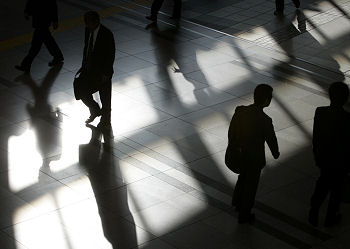by Paul Wagenseil / FOX News
Image taken by NASA's SOHO satellite on July 1, 2002
The severe geomagnetic storm bombarding the Earth on Thursday was expected to disrupt radio, television and cell-phone communications worldwide and could force airlines to reroute passenger flights that normally fly over the North Pole.
Power-grid operators will have to make sure their systems do not overload from induced current, and satellites in close Earth orbits will need to have their positions constantly monitored as the atmosphere expands from the additional heat and frictional drag increases.
"It's really hitting the Earth's magnetic field pretty hard," Joseph Kunches, lead forecaster at the NOAA Space Environment Center in Boulder, Colo., told FOXNews.com. "It's already affected HF [high-frequency] radio on the other side of the globe, as well as the astronauts aboard the ISS [international space station]." As Kunches spoke, the Space Environment Center's atmospheric magnetic sensors oscillated wildly, meaning that the charge of the particles hitting the planet swung drastically between positive and negative.
A large sunspot, dubbed number 930, ejected a major X-3 category solar flare late Tuesday, blanketing two astronauts at the end of a spacewalk with X-rays within minutes. A few hours later, a wave of accelerated protons hit the space station and attached space shuttle Discovery, but the astronauts were already sheltered behind protective bulkheads and airlocks. Earthbound organisms and electronics were in no danger from those initial waves, but at about 8:45 a.m. EST Thursday, about 36 hours after the initial flare, a slow-moving coronal mass ejection — basically a strong solar-wind gust of subatomic particles plus a large magnetic field — began hitting the planet.
"It's not the worst-case scenario," Kunches explained. "It's not as bad as, say, the Halloween storm of 2003, but it will probably cause the auroras to move toward the Equator tonight, meaning that the northern lights may be visible from the continental United States. Airlines will also have to think about whether it's safe to fly the polar routes," he added. "They might have to consider flying at lower altitudes, or not flying over the poles at all."
The Earth's magnetic field is like a doughnut encircling the planet, and deflects most charged particles that arrive from space. However, since the "holes" of the doughnut plunge into the Earth at the north and south magnetic poles, a certain amount of space radiation penetrates the atmosphere deeply, even hitting the surface, at those locations.
Humans inside airplanes flying high over the magnetic poles are thus exposed to elevated levels of cosmic radiation even under normal space-weather conditions. During a severe geomagnetic storm, it might not be worth getting off the ground.
"There's still no one answer for what a 'safe' amount of radiation would be," Kunches said. He added that the technological implications of the storm were more clearly defined. "As the solar wind hits the atmosphere, it expands," he explained, "which increases the frictional drag on satellites traveling around the Earth. Ground-based operators will have to keep track of their positions, which will be further complicated by radio-signal interference from the storm." Regional electrical networks are at risk as well. "Induced current will enter power grids," said Kunches, "and operators will have to make sure their systems don't overload." Thanks to the terrestrial magnetosphere, the overall effect on biological organisms will be little. That wouldn't be the case, though, for astronauts staffing a future Moon base. "If, 20 years from now, the same sort of storm were to hit a Moon base," said Kunches, "the impact upon people there would be very much worse. They'd have no magnetic field to protect them."
Friday, December 15, 2006
Solar Storm May Ground Aircraft, Overload Power Grids
Posted by
Charlie
at
8:21 AM
![]()
Labels: coronal mass ejection, cosmic radiation, geomagnetic storm, solar-wind, subatomic particles, terrestrial magnetosphere




